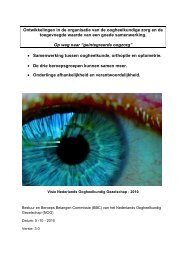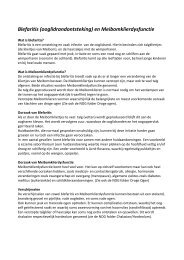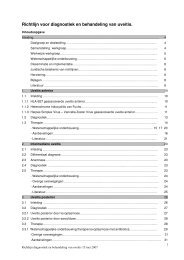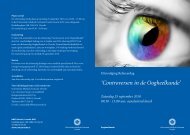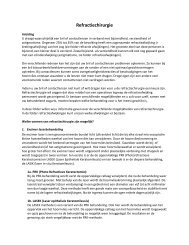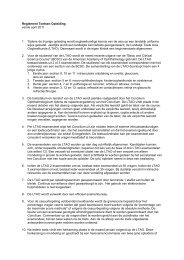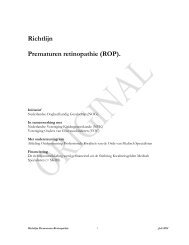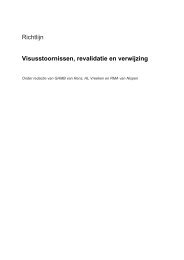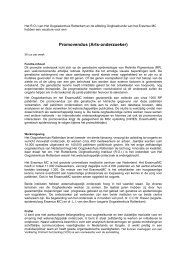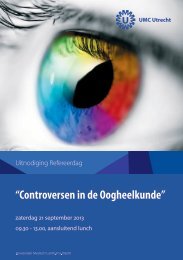terminology and guidelines for glaucoma ii - Kwaliteitskoepel
terminology and guidelines for glaucoma ii - Kwaliteitskoepel
terminology and guidelines for glaucoma ii - Kwaliteitskoepel
Create successful ePaper yourself
Turn your PDF publications into a flip-book with our unique Google optimized e-Paper software.
3.3.2.1 - Category: ADRENERGIC ANTAGONISTS ANDPARASYMPATHOMIMETICS<br />
ß-Blockers & Pilocarpine<br />
Generics<br />
Metipranolol 0.1% <strong>and</strong> pilocarpine 2%<br />
Timolol 0.5% <strong>and</strong> pilocarpine 1% to 4%<br />
Carteolol 2% <strong>and</strong> Pilocarpine<br />
Tradenames<br />
Ripix, Normoglaucon<br />
Timpilo, Fotil ,Equiton, Timicon.<br />
Carpilo<br />
Action<br />
Decreased intraocular pressure by reduction of the aqueous humor production.<br />
Increase a facility of outflow of aqueous humor. Direct action on longitudinal ciliary muscle.<br />
Peak effect in 2 hrs.<br />
Dosage <strong>and</strong> administration<br />
Starting dose is one drop of lowest concentration of solution in the affected eye twice a day. If the clinical response is<br />
not adequate, the dosage may be increased to one drop of a higher concentration. Dosing more than twice daily will<br />
not give any further pressure lowering effect.<br />
Indications<br />
Elevations of intraocular pressure in patients where the IOP can be deleterious <strong>for</strong> the preservation of visual function,<br />
where the target IOP is not obtained with less potent agents.<br />
Major Contraindications<br />
Asthma, history of obstructive pulmonary disease, sinus bradycardia (< 60 beats/min), heart block, or cardiac failure.<br />
Relative contraindication in history of obstructive pulmonary disease,<br />
Young age < 40 yrs old, cataract, uveitis <strong>and</strong> neovascular <strong>glaucoma</strong>. Assess worsening of pupillary block in angleclosure<br />
<strong>glaucoma</strong>s.<br />
Precautions<br />
Extreme caution in patients with marked vagotonia, bronchial asthma, spastic gastrointestinal disturbances, peptic<br />
ulcer, pronounced bradycardia <strong>and</strong> hyotension, recent myocardial infarction, epilepsy <strong>and</strong> Parkinsonism. Prior<br />
history of retinal detachment or rhegmatogenous retinal lesions.<br />
Major side effects<br />
Systemic: Bradycardia, arrhythmia, heart failure, syncope, bronchospasm, <strong>and</strong> airways obstruction. Peripheral<br />
edema, hypotension. Depression. Hypoglycemia may be masked in insulin dependent diabetes mellitus.<br />
Intestinal cramps.<br />
Ocular: Epithelial keratopathy, slight reduction in corneal sensitivity. Miosis, pseudomyopia, browache, retinal<br />
detachment, ciliary spasm, increased pupillary block.<br />
Pregnancy <strong>and</strong> nursing mothers<br />
Only to be used if the potential benefit justifies the potential risk to the fetus or the infant.<br />
Drug interactions<br />
Caution should be used in the co-administration of beta-adrenergic blocking agents <strong>and</strong> oral or intravenous calcium<br />
antagonists, because of possible atrioventricular conduction disturbances, left ventricular failure, <strong>and</strong> hypotension.<br />
Digitalis <strong>and</strong> calcium antagonists: the concomitant use of beta-adrenergic blocking agents with digitalis <strong>and</strong> calcium<br />
antagonists may have additive effects in prolonging conduction time.<br />
A competitive dualism on outflow with prostagl<strong>and</strong>ins is assumed, since parasympathomimetics induce contraction<br />
of the ciliary muscle which reduces the uveoscleral space.<br />
Wash-out<br />
The time needed <strong>for</strong> beta blockers to lose their activity completely is 2-4 weeks; <strong>for</strong> pilocarpine is 1-3 days.<br />
Ch. 3 - 23 EGS



